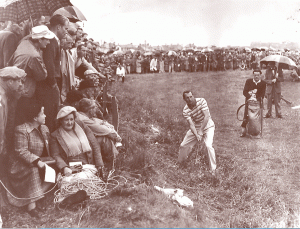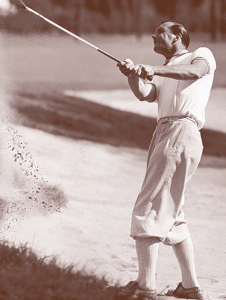 By Mike Stevens, USGTF Teaching Professional Tampa, Florida
By Mike Stevens, USGTF Teaching Professional Tampa, Florida
In 1951 the Open Championship was played outside Great Britain for the first time. The site was Royal Portrush in Northern Ireland, which hosts once again this year. I could not find a reason for going there other than it is a beautiful course with magnificent landscape. I guess the R&A just wanted a change of pace.
The odds-on favorite going in was defending champion Bobby Locke of South Africa. Max Faulkner, the eventual winner, on the other hand was a decent player with a few minor tournament victories in England. Born on England’s south coast in 1916, he was introduced to the game by his father Gus, a former assistant to the great James Braid. Max was a multisport talent, but golf seemed to be his favorite pastime. He joined his dad as an assistant pro after his schooling and started getting some notoriety as a potential player until the big one began. From 1939 to 1945, he played exactly two rounds of golf while serving his country in defeating the German war machine.
Once peace returned, Faulkner went back to work on his game, which came back quickly, but what he was most noted for was his dashing attire in bold colors and cheerful disposition. Entering the ’51 Open, he had a good feeling about his chances. He played Portrush in the Irish Open at21, finishing third, and felt it favored his power fade as most of the holes have a right-hand curve. He al so believed a very light putter, one of the many he owned, would come in handy on the fastest greens of all Open venues. His premonition was correct, needing only 51 putts with the magic wand in the first two rounds to top the leaderboard with a score of 141. The final two rounds of the Open in those days were played on the same day, and Max, playing well in the morning round, came to the 16th hole well in the lead, but hit a disastrous drive that landed within two feet of a barbed-wire boundary fence. But Max believed it was his day. Rather than chip out, he took his 4-wood and with his backside against the barbs, he abruptly cut the ball out over the OB fence, curving the ball on to the putting surface. His playing partner, American Frank Stranahan, walked over and commented to him that it was the finest shot he had ever seen. Faulkner would finish the third round six shots clear of the field.
 Here is where the story gets even more interesting. After a brief respite, Max headed for the first tee. As he walked, a young boy approached and asked him to sign a ball, but Faulkner was reluctant, not wanting to be distracted. Then the boy said, “You’re going to win,” and at the urging of the boy’s father who mentioned how much it would mean to the boy, Max signed the ball – Max Faulkner, Open Champion 1951. For the first time, he let the thought of blowing a big lead enter his mind, and struggled a bit coming home in 74. There were no scoreboards at the time, so runners were dispatched to and from to let people know what was going on with players still on the course. Word came in that Tony Cerda had turned in 34 and was a threat to catch the leader. A bit later, the word was that three fours on the final holes would tie Faulkner. A final messenger approached Max and related to him, “Cerda’s taken six; it’s your Open.”His dream had proved true – he was the Champion Golfer of the Year. The Claret Jug held by South African Bobby Locke would be returning to Britain.
Here is where the story gets even more interesting. After a brief respite, Max headed for the first tee. As he walked, a young boy approached and asked him to sign a ball, but Faulkner was reluctant, not wanting to be distracted. Then the boy said, “You’re going to win,” and at the urging of the boy’s father who mentioned how much it would mean to the boy, Max signed the ball – Max Faulkner, Open Champion 1951. For the first time, he let the thought of blowing a big lead enter his mind, and struggled a bit coming home in 74. There were no scoreboards at the time, so runners were dispatched to and from to let people know what was going on with players still on the course. Word came in that Tony Cerda had turned in 34 and was a threat to catch the leader. A bit later, the word was that three fours on the final holes would tie Faulkner. A final messenger approached Max and related to him, “Cerda’s taken six; it’s your Open.”His dream had proved true – he was the Champion Golfer of the Year. The Claret Jug held by South African Bobby Locke would be returning to Britain.
Max Faulkner would go on to win 16 tournaments in Europe, but never another Open Championship. It was his crowning achievement and all he ever wanted. He also played on five Ryder Cup teams, including the surprise 1957 team in which Britain won for the first time since 1933.
Another interesting chapter in his life came in1973 during the Open at Troon. He was paired with Gene Sarazen when Sarazen recorded a hole-in-one at the famed Postage Stamp. It was Sarazen and Walter Hagen who were models for Faulkner’s snappy attire on the golf course.
Max Faulkner played for six decades, observing golf from the hickory era to the many changes in ball and club technology. A true sportsman, he could have played professionally at tennis, cricket or soccer, but golf was his true love. On the 50thanniversary of his triumph in the Open, he was honored with the Order of the British Empire for his service to golf. He lived out his remaining years in Sussex and passed away in 2005 after contracting pneumonia at the age of 88, a true gentleman of the game who should not be forgotten.
Copyright © 2023 United States Golf Teachers Federation, All Rights Reserved
200 S. Indian River Drive, Suite #206, Fort Pierce, FL 34950
772-88-USGTF or 772-595-6490 - www.usgtf.com
200 S. Indian River Drive, Suite #206, Fort Pierce, FL 34950
772-88-USGTF or 772-595-6490 - www.usgtf.com
